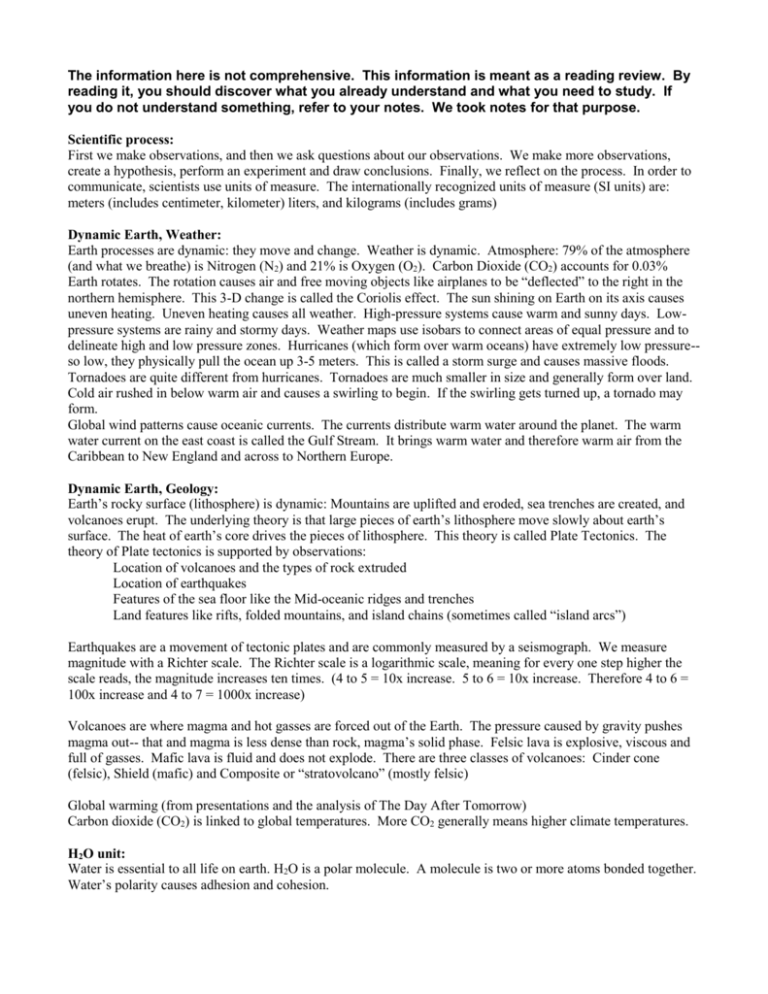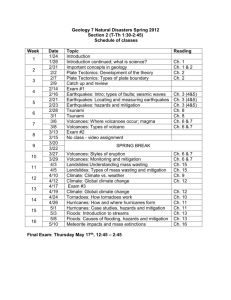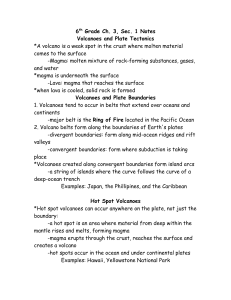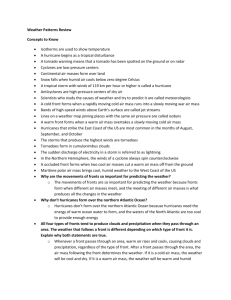S1%20exm%20review
advertisement

The information here is not comprehensive. This information is meant as a reading review. By reading it, you should discover what you already understand and what you need to study. If you do not understand something, refer to your notes. We took notes for that purpose. Scientific process: First we make observations, and then we ask questions about our observations. We make more observations, create a hypothesis, perform an experiment and draw conclusions. Finally, we reflect on the process. In order to communicate, scientists use units of measure. The internationally recognized units of measure (SI units) are: meters (includes centimeter, kilometer) liters, and kilograms (includes grams) Dynamic Earth, Weather: Earth processes are dynamic: they move and change. Weather is dynamic. Atmosphere: 79% of the atmosphere (and what we breathe) is Nitrogen (N2) and 21% is Oxygen (O2). Carbon Dioxide (CO2) accounts for 0.03% Earth rotates. The rotation causes air and free moving objects like airplanes to be “deflected” to the right in the northern hemisphere. This 3-D change is called the Coriolis effect. The sun shining on Earth on its axis causes uneven heating. Uneven heating causes all weather. High-pressure systems cause warm and sunny days. Lowpressure systems are rainy and stormy days. Weather maps use isobars to connect areas of equal pressure and to delineate high and low pressure zones. Hurricanes (which form over warm oceans) have extremely low pressure-so low, they physically pull the ocean up 3-5 meters. This is called a storm surge and causes massive floods. Tornadoes are quite different from hurricanes. Tornadoes are much smaller in size and generally form over land. Cold air rushed in below warm air and causes a swirling to begin. If the swirling gets turned up, a tornado may form. Global wind patterns cause oceanic currents. The currents distribute warm water around the planet. The warm water current on the east coast is called the Gulf Stream. It brings warm water and therefore warm air from the Caribbean to New England and across to Northern Europe. Dynamic Earth, Geology: Earth’s rocky surface (lithosphere) is dynamic: Mountains are uplifted and eroded, sea trenches are created, and volcanoes erupt. The underlying theory is that large pieces of earth’s lithosphere move slowly about earth’s surface. The heat of earth’s core drives the pieces of lithosphere. This theory is called Plate Tectonics. The theory of Plate tectonics is supported by observations: Location of volcanoes and the types of rock extruded Location of earthquakes Features of the sea floor like the Mid-oceanic ridges and trenches Land features like rifts, folded mountains, and island chains (sometimes called “island arcs”) Earthquakes are a movement of tectonic plates and are commonly measured by a seismograph. We measure magnitude with a Richter scale. The Richter scale is a logarithmic scale, meaning for every one step higher the scale reads, the magnitude increases ten times. (4 to 5 = 10x increase. 5 to 6 = 10x increase. Therefore 4 to 6 = 100x increase and 4 to 7 = 1000x increase) Volcanoes are where magma and hot gasses are forced out of the Earth. The pressure caused by gravity pushes magma out-- that and magma is less dense than rock, magma’s solid phase. Felsic lava is explosive, viscous and full of gasses. Mafic lava is fluid and does not explode. There are three classes of volcanoes: Cinder cone (felsic), Shield (mafic) and Composite or “stratovolcano” (mostly felsic) Global warming (from presentations and the analysis of The Day After Tomorrow) Carbon dioxide (CO2) is linked to global temperatures. More CO2 generally means higher climate temperatures. H2O unit: Water is essential to all life on earth. H2O is a polar molecule. A molecule is two or more atoms bonded together. Water’s polarity causes adhesion and cohesion. Name: ___________________________ Block: _______ Most of your final exam came from old California State Test (CST) questions. Many of the questions are difficult and all of them use scientific language and exact grammar. If you can thoroughly answer the 30 questions on this page using scientific language, you’re “hecka ready” for the final exam! 1. What is a hypothesis? 2. Using math and units… I need 2 eggs to make a batch of cookies. One batch of cookies is 36 cookies. If I have 1 and ½ dozen eggs, how many cookies can I make? 3. 4. 5. 6. 7. 8. 9. 10. 11. 12. What is the leading cause of weather on earth? Why does that happen? What 2 gasses make up 99.9% of the atmosphere? What are their respective percentages? What is the Coriolis effect? Describe the weather in a high-pressure system Describe the weather in a low-pressure system Where do hurricanes form? How does a storm surge work? How are tornadoes different from hurricanes? What are 2 affects of ocean currents on the planet? 13. 14. 15. 16. Are mountains, sea floor trenches and rift valleys permanent? What does the lithosphere refer to? What is a tectonic plate? What are three observations that support the theory of plate tectonics? 17. 18. 19. 20. Where do earthquakes occur? What is the common instrument and scale that measure quakes? What does magnitude mean? How many times stronger is a “7” than a “6” earthquake? 21. Where are volcanoes usually found? 22. What are three classes of volcanoes? 23. Which lava type is explosive and which type is runny? 24. Why are we concerned about global warming? 25. What role do we believe CO2 plays in global warming? 26. Why do we study water? 27. What is the difference in a molecule and an atom? 28. What do adhesion and cohesion mean? 29. How does the topic of your dynamic earth project shape the earth? 30. How do people prepare for the topic of your dynamic earth project?







